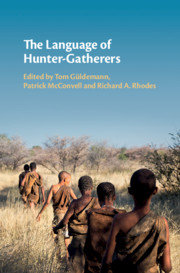Book contents
- The Language of Hunter-Gatherers
- The Language of Hunter-Gatherers
- Copyright page
- Dedication
- Contents
- Figures
- Maps
- Tables
- Contributors
- Preface
- Part I Introduction
- 1 Hunter-Gatherer Anthropology and Language
- 2 Genetic Landscape of Present-Day Hunter-Gatherer Groups
- 3 Linguistic Typology and Hunter-Gatherer Languages
- 4 Ethnobiology and the Hunter-Gatherer/Food Producer Divide
- Part II Africa
- Part III Tropical Asia
- Part IV New Guinea and Australia
- Part V Northeastern Eurasia
- Part VI North America
- Part VII South America
- Appendix A Preliminary Worldwide Survey of Forager Languages
- Language Index
- Subject Index
- References
1 - Hunter-Gatherer Anthropology and Language
from Part I - Introduction
Published online by Cambridge University Press: 26 February 2020
- The Language of Hunter-Gatherers
- The Language of Hunter-Gatherers
- Copyright page
- Dedication
- Contents
- Figures
- Maps
- Tables
- Contributors
- Preface
- Part I Introduction
- 1 Hunter-Gatherer Anthropology and Language
- 2 Genetic Landscape of Present-Day Hunter-Gatherer Groups
- 3 Linguistic Typology and Hunter-Gatherer Languages
- 4 Ethnobiology and the Hunter-Gatherer/Food Producer Divide
- Part II Africa
- Part III Tropical Asia
- Part IV New Guinea and Australia
- Part V Northeastern Eurasia
- Part VI North America
- Part VII South America
- Appendix A Preliminary Worldwide Survey of Forager Languages
- Language Index
- Subject Index
- References
Summary
Foragers are often portrayed as “others” standing outside the main trajectory of human social evolution, which began with the Neolithic Revolution. In some forms of this narrative, foragers are static, left behind in the tide of history by their dynamic cousins, the farmers.
- Type
- Chapter
- Information
- The Language of Hunter-Gatherers , pp. 3 - 48Publisher: Cambridge University PressPrint publication year: 2020
References
- 4
- Cited by

